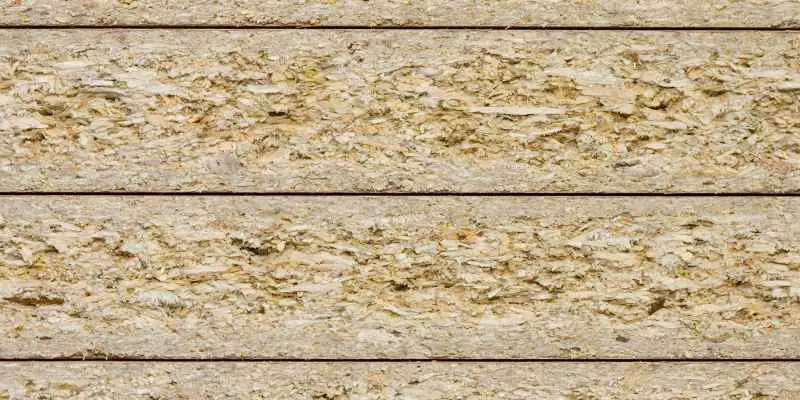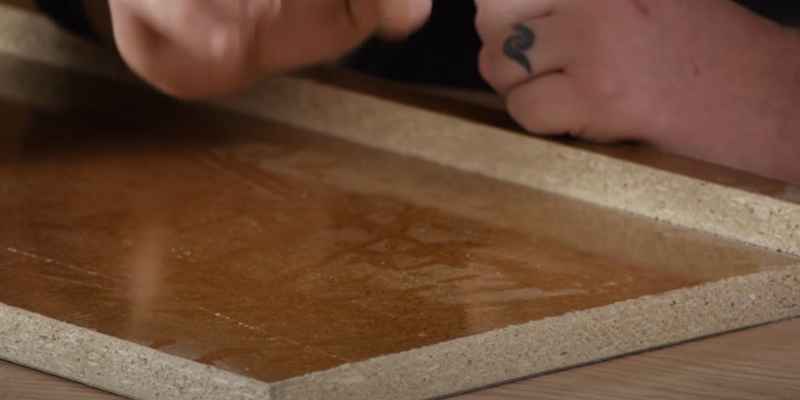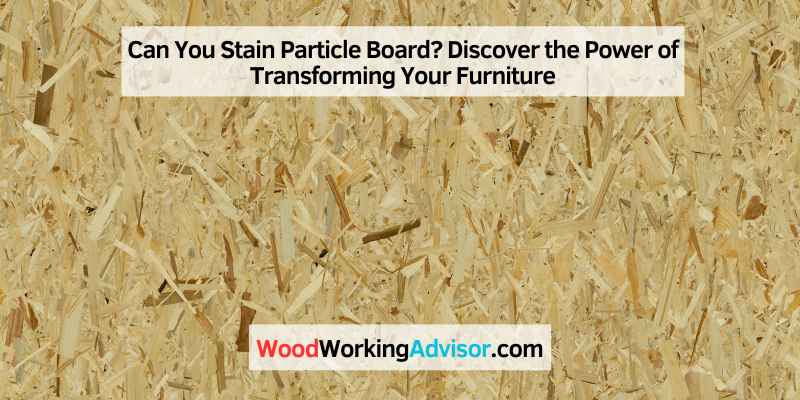Yes, you can stain particle board. Particle board is a versatile material that can be stained to achieve the desired color and finish.
However, it is important to properly prepare the surface and use the right techniques to ensure an even and long-lasting finish. Staining particle board requires sanding the surface to remove any existing finish, applying an appropriate wood stain, and finishing with a protective topcoat.
By following these steps and using the correct materials, you can successfully stain particle board and enhance its appearance.
Benefits Of Staining Particle Board
Staining particle board is a cost-effective way to transform the look and feel of this commonly used material. By introducing color and protection to the surface, staining particle board offers several benefits that can enhance both the appearance and durability of your furniture or projects. Let’s explore the advantages of staining particle board!
Enhances The Appearance
Staining particle board can give an ordinary piece of furniture a whole new look. With a wide variety of stain colors available, you can easily find one that complements the style and decor of your space. Whether you prefer a warm and rich wood tone or a modern and bold color, staining particle board can help you achieve the desired aesthetic.
The staining process helps to highlight the natural grain patterns and texture of the particle board, creating a more visually appealing finish. By using a combination of different stains or experimenting with techniques like distressing or antiquing, you can add depth and character to the surface, making it look more like solid wood.
Protects Against Wear And Tear
Particle board is known for being susceptible to damage, such as scratches, dents, and moisture absorption. However, by staining particle board, you can provide an extra layer of protection that helps to keep it looking newer for longer.
The stain penetrates the surface of the particle board, sealing it and enhancing its resistance to everyday wear and tear. This makes the board more durable and helps guard against scratches, spills, and other potential damage. With a protective stain, you can extend the lifespan of your particle board furniture and preserve its appearance.
Additionally, staining particle board can also help prevent moisture or humidity from seeping into the material. By sealing the surface, you create a barrier that reduces the risk of warping, swelling, or mold growth, which can be particularly beneficial in areas with higher humidity levels.
| Benefits of Staining Particle Board |
|---|
| Enhances the appearance |
| Protects against wear and tear |
Overall, staining particle board is a practical and budget-friendly way to improve the look of your furniture and increase its durability. Whether you are refinishing old pieces or working on a DIY project, consider staining particle board to take advantage of its many benefits.

Preparing Particle Board For Staining
Staining particle board requires careful preparation to ensure satisfactory results.
When it comes to staining particle board, proper preparation is key to achieving a beautiful and long-lasting finish. While particle board is not as durable or resistant to moisture as solid wood, with the right steps, it can still be successfully stained to enhance its appearance. In this section, we will explore the necessary steps to prepare particle board for staining, including cleaning the surface and sanding the board.
Cleaning The Surface
Before starting the staining process, it is important to thoroughly clean the particle board surface to remove any dirt, dust, or grease that might interfere with the adhesion of the stain. Here’s how you can clean the surface effectively:
- Dust off the particle board using a soft cloth or a vacuum cleaner with a brush attachment to remove loose debris.
- Next, prepare a mixture of mild dish soap and warm water.
- Dip a sponge or soft cloth into the soapy solution and gently scrub the particle board surface in a circular motion. Be careful not to saturate the board with water, as excessive moisture can cause damage.
- Once you have thoroughly cleaned the surface, rinse it with a clean, damp cloth to remove any soap residue.
- Finally, allow the particle board to air dry completely before proceeding to the next step.
Sanding The Board
Sanding the particle board is an essential step in preparing it for staining. This process helps to smooth out any rough patches and allows the stain to penetrate the surface more evenly. Follow these steps to achieve a properly sanded particle board:
- Start by using a medium-grit sandpaper (around 120-150 grit) to sand the entire surface of the particle board. Sand in the direction of the wood grain, applying gentle pressure.
- Focus particularly on any rough areas, seams, or edges that require additional smoothing.
- After sanding, wipe away the dust using a damp cloth or vacuum cleaner with a brush attachment. It is crucial to remove all dust particles to ensure a clean surface for staining.
- For a smoother finish, follow up with a finer-grit sandpaper (around 180-220 grit) to lightly sand the surface again.
- Once you have completed the sanding process, thoroughly clean the particle board surface one more time to remove any remaining dust.
By meticulously following these steps to clean and sand your particle board surface, you will create an ideal foundation for applying the stain. With proper preparation, you can achieve a stunning stained finish on your particle board furniture or projects, bringing new life and visual appeal to these versatile materials.
Choosing The Right Stain
When it comes to staining particle board, choosing the right stain is crucial to achieving the desired look and protecting the surface. There are a few factors to consider when making this decision, including the type of stain and the color options and effects available.
Water-based Vs. Oil-based Stains
One of the first decisions you’ll need to make when choosing a stain is whether to go with a water-based or an oil-based option. Each type of stain has its advantages and it’s important to understand the differences between the two.
Water-based stains are easy to clean up and have a low odor. They also dry quickly, which can be beneficial if you’re in a rush to complete your project. On the other hand, oil-based stains typically offer more durability and tend to produce a deeper, richer color.
Consider your specific needs and preferences when deciding between water-based and oil-based stains. If you’re looking for a quick and hassle-free application, a water-based stain might be the right choice. However, if you prioritize durability and a rich color, an oil-based stain may be more suitable.
Color Options And Effects
Another important aspect of choosing the right stain for particle board is considering the color options and effects available. Stains come in a wide range of colors, allowing you to achieve various aesthetics and finishes.
Consider the overall style and color scheme of the room or piece of furniture you’ll be staining. Do you prefer a natural wood look, or are you looking to add a pop of color? Keep in mind that some stains may darken the wood significantly, while others may enhance the natural color or create variations.
It may be helpful to create a color swatch or sample on a small piece of particle board before committing to a larger project. This way, you can see how the stain will react with the surface and adjust your choice as needed.
Overall, choosing the right stain for your particle board involves considering factors such as the type of stain and the color options and effects available. By carefully evaluating your preferences and considering the desired outcome of your project, you can achieve a beautiful and durable stained finish.
Staining Techniques For Particle Board
Particle board, although not typically known for its ability to be stained, can actually be transformed with the right staining techniques. Whether you want to enhance the natural wood grain or achieve a different finish, there are different methods you can use to stain particle board. In this post, we will explore three common staining techniques for particle board: brushing, wiping, and spraying.
Brushing
Brushing is a popular staining technique for particle board as it allows for greater control and precision. To brush stain onto particle board:
- Start by preparing the particle board surface by sanding it lightly to remove any roughness.
- Choose a suitable brush for the stain you are using, making sure to match the size of the brush to the size of the surface you are staining.
- Dip the brush into the stain and remove any excess stain by lightly tapping it against the side of the container.
- Apply the stain to the particle board using long, even, and overlapping strokes in the direction of the wood grain.
- Allow the first coat of stain to dry completely before applying additional coats if desired.
- After applying the desired number of coats, let the stain dry thoroughly before applying a protective finish.
Wiping
Wiping is another effective staining technique for particle board that can create a more even, uniform finish. To stain particle board using the wiping technique:
- Sand the particle board to create a smooth surface.
- Choose a cloth or sponge that is appropriate for the size of the surface you are staining.
- Pour the stain onto the cloth or sponge, ensuring it is saturated but not dripping.
- Wipe the stain onto the particle board in long, even, and overlapping motions, following the direction of the wood grain.
- Allow the first coat to dry completely before applying additional coats if desired.
- Once the desired number of coats has been applied, allow the stain to dry thoroughly before applying a protective topcoat.
Spraying
Spraying stain onto particle board can result in a smooth, uniform finish, especially for larger surfaces. Here is how to stain particle board using the spraying technique:
- Sand the particle board to create a smooth, even surface.
- Prepare the stain by following the manufacturer’s instructions for mixing and thinning, if necessary.
- Pour the stain into a paint sprayer, making sure it is properly adjusted for the desired spray pattern.
- Hold the sprayer nozzle a few inches away from the particle board surface and apply the stain in smooth, controlled motions.
- Allow the first coat to dry completely before applying additional coats if desired.
- Once the desired number of coats has been applied, let the stain dry thoroughly before applying a protective finish.
By using these staining techniques for particle board, you can transform your furniture or other items made from this material, giving them a new look and feel. Remember to always follow safety guidelines and work in a well-ventilated area when using stains and finishes.

Applying The Stain And Finishing
Yes, you can stain particle board to give it a new look and finish. With proper preparation and techniques, staining particle board can result in a beautiful and durable finish that enhances the appearance of the furniture or surface.
Applying The First Coat
Now that you’ve prepped your particle board and chosen the perfect stain color, it’s time to apply the first coat. Before you begin, make sure you’re working in a well-ventilated area and wearing appropriate safety gear, such as gloves and a mask.
To apply the stain, you can use a brush, a foam applicator, or a clean cloth. Start by dipping the tool of your choice into the stain and wiping off any excess. Begin applying the stain in long, even strokes, following the grain of the particle board. Be sure to cover the entire surface, including the edges.
Once the first coat is applied, allow it to dry according to the instructions provided by the stain manufacturer. This usually takes around 24 hours, but it’s always recommended to double-check the drying time to ensure the best results.
Sanding Between Coats
After the first coat has dried, it’s time to take your sandpaper and smooth out any imperfections. Sanding between coats not only helps to remove any rough spots but also improves the adhesion of subsequent coats.
When sanding, use a fine-grit sandpaper (around 220-grit) and sand in the direction of the particle board’s grain. Work gently to avoid removing too much of the first coat. Once you’ve sanded the surface, wipe away the dust with a clean, dry cloth.
Remember, sanding between coats is an essential step that helps to achieve a smooth and professional-looking finish. Don’t skip this step, as it can make a significant difference in the final result.
Adding A Protective Finish
Now that you have applied multiple coats of stain and achieved the desired color, it’s time to add a protective finish. A protective finish not only gives your particle board a polished appearance but also helps to protect it from daily wear and tear.
There are various types of protective finishes you can choose from, such as polyurethane, varnish, or lacquer. Before applying the finish, make sure to read the instructions provided by the manufacturer to ensure proper application and drying times.
Using a brush or foam applicator
Apply a thin and even layer of the protective finish, following the grain of the particle board. Allow the finish to dry completely before applying additional coats. Depending on the type of finish you choose, you may need to sand between coats for optimal results.
Once you have applied the recommended number of coats, allow the protective finish to cure according to the manufacturer’s instructions. This curing period ensures maximum durability and longevity for your particle board.
In conclusion, applying stain to particle board and adding a protective finish can transform its appearance and enhance its durability. By following the right techniques, such as applying the first coat evenly, sanding between coats, and adding a protective finish, you can achieve a beautiful and long-lasting finish that will make your particle board look like real wood.
Conclusion
To sum up, staining particle board can be a viable option to enhance its appearance and give it a more natural look. However, it is crucial to prepare the surface properly and choose the right stain to ensure successful results.
Whether you are refinishing furniture or DIY-ing a project, following the proper steps and techniques will help you achieve the desired outcome. So, go ahead and experiment with stains on your particle board surfaces to transform them into beautiful pieces that fit your aesthetic preferences.


